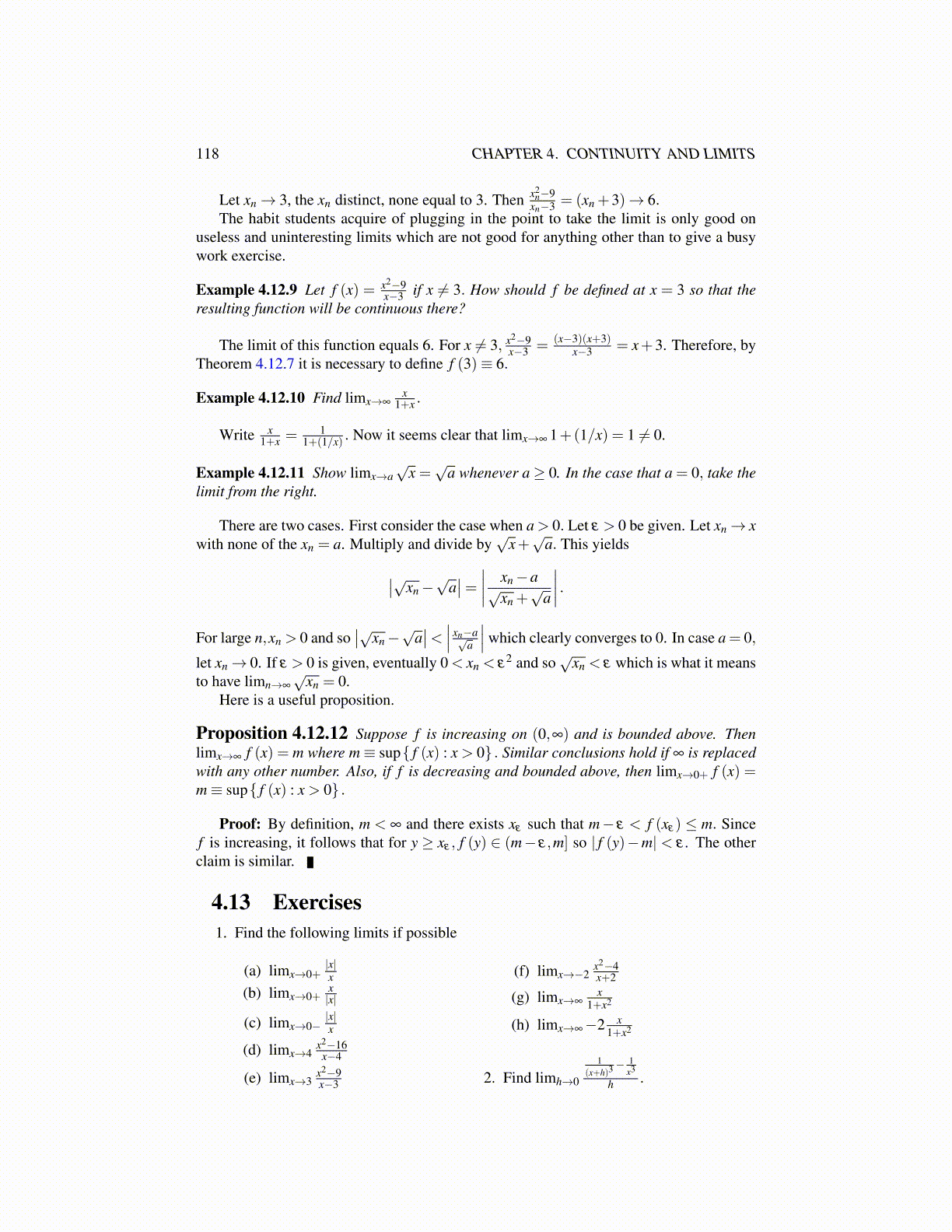
118 CHAPTER 4. CONTINUITY AND LIMITS
Let xn → 3, the xn distinct, none equal to 3. Then x2n−9
xn−3 = (xn +3)→ 6.The habit students acquire of plugging in the point to take the limit is only good on
useless and uninteresting limits which are not good for anything other than to give a busywork exercise.
Example 4.12.9 Let f (x) = x2−9x−3 if x ̸= 3. How should f be defined at x = 3 so that the
resulting function will be continuous there?
The limit of this function equals 6. For x ̸= 3, x2−9x−3 = (x−3)(x+3)
x−3 = x+3. Therefore, byTheorem 4.12.7 it is necessary to define f (3)≡ 6.
Example 4.12.10 Find limx→∞x
1+x .
Write x1+x = 1
1+(1/x) . Now it seems clear that limx→∞ 1+(1/x) = 1 ̸= 0.
Example 4.12.11 Show limx→a√
x =√
a whenever a ≥ 0. In the case that a = 0, take thelimit from the right.
There are two cases. First consider the case when a > 0. Let ε > 0 be given. Let xn → xwith none of the xn = a. Multiply and divide by
√x+
√a. This yields
∣∣√xn −√
a∣∣= ∣∣∣∣ xn −a
√xn +
√a
∣∣∣∣ .For large n,xn > 0 and so
∣∣√xn −√
a∣∣< ∣∣∣ xn−a√
a
∣∣∣ which clearly converges to 0. In case a = 0,
let xn → 0. If ε > 0 is given, eventually 0 < xn < ε2 and so√
xn < ε which is what it meansto have limn→∞
√xn = 0.
Here is a useful proposition.
Proposition 4.12.12 Suppose f is increasing on (0,∞) and is bounded above. Thenlimx→∞ f (x) = m where m ≡ sup{ f (x) : x > 0} . Similar conclusions hold if ∞ is replacedwith any other number. Also, if f is decreasing and bounded above, then limx→0+ f (x) =m ≡ sup{ f (x) : x > 0} .
Proof: By definition, m < ∞ and there exists xε such that m− ε < f (xε) ≤ m. Sincef is increasing, it follows that for y ≥ xε , f (y) ∈ (m− ε,m] so | f (y)−m| < ε . The otherclaim is similar.
4.13 Exercises1. Find the following limits if possible
(a) limx→0+|x|x
(b) limx→0+x|x|
(c) limx→0−|x|x
(d) limx→4x2−16x−4
(e) limx→3x2−9x−3
(f) limx→−2x2−4x+2
(g) limx→∞x
1+x2
(h) limx→∞−2 x1+x2
2. Find limh→0
1(x+h)3
− 1x3
h .